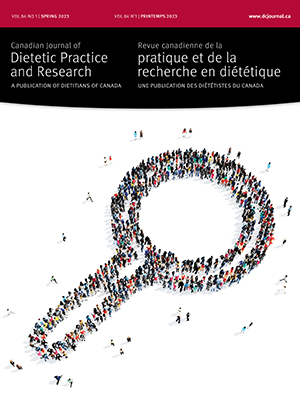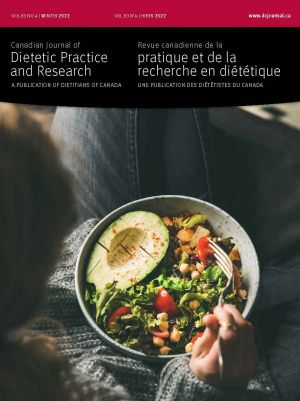Volume 67 • Number 1 • March 2006
Chair’s Message
Editor’s Message
Research
Purpose: Food sources of nutrients in the Canadian diet were explored. Knowledge of these sources is important to public health professionals and to those in clinical practice. Methods: Using data from the Food Habits of Canadians study, we investigated nutrient sources from detailed food groupings in a sample of 1,543 adults (971 women, 572 men) from across Canada. Subjects were interviewed by trained dietitians. At the time of the interview, a sociodemographic questionnaire and a 24-hour dietary recall were completed. Results: The response rate was 30%. Subjects aged 18 to 34 reported eating more prepared and convenience foods than did those aged 35 to 65. Energy was contributed mainly by breads, pasta, rice, grains, and fluid milk. Protein intake was primarily derived from meat and dairy products; legumes, nuts, seeds, and eggs were not high contributors. For men aged 35 to 65 and women aged 18 to 65, butter, margarine, and oil were the primary fat sources; they were the second most common source for men aged 18 to 34. Fibre was provided by foods that are not usually considered good sources, but because of the large total consumption of these foods, they are important in Canadians’ diet. The main source of calcium was dairy products, and iron came mainly from non-heme sources. Conclusions: We must understand the contributions of foods to nutrients, and distinguish “important” sources of nutrients (those consumed by many in substantial amounts) from “good” sources (foods rich in particular nutrients, whether eaten or not).
Purpose: To identify definitions of healthy eating in terms of food characteristics, eating behaviours, barriers, and benefits in university students. Methods: Four focus groups were conducted; verbatim transcripts were analyzed and coded using qualitative methods. Participants were nine students of dietetics and six students of other subjects. All were females in their third or fourth year at the University of British Columbia (UBC). Results: Participants often described healthy eating as consuming all food groups of Canada’s Food Guide to Healthy Eating, with the associated notions of moderation and balance. Benefits of healthy eating were cited as a healthy weight, good physical appearance, feeling better, preventing disease, and achieving personal satisfaction. Barriers to healthy eating included lack of time, choice, taste preferences, and finances. There was some discrepancy between what the dietetics students perceived as barriers for clients (e.g., lack of information), and barriers the potential clients (other students) perceived for themselves. Conclusions: As dietitians, we must try to understand our clients’ definitions of healthy eating and their barriers to achieving it, which likely differ from our own.
Purpose: Several health organizations, including the Canadian Diabetes Association, advocate use of the glycemic index (GI) in the nutritional management of diabetes. However, the clinical utility and applications of the GI remain controversial. Our goal was to determine, via a postal survey, whether dietitians were using the GI and barriers to its use if they were not. Methods: This cross-sectional study was conducted in 2003. Members of Dietitians of Canada and the Ordre professionnel des diététistes du Québec (n=6,060) were first contacted by mail to identify those working with individuals with diabetes. Among respondents (n=2,857), 1,805 worked with individuals with diabetes and were sent a questionnaire. Using Chi-square analyses, users and nonusers were compared for their professional characteristics, perceived benefits, barriers, general knowledge about the concept, and confidence in teaching the GI. Results: Among questionnaire respondents (n=1,057), 39% (n=415) used the GI and 61% (n=642) did not. Overall, users were more likely to have a greater diabetes patient caseload, perceived greater benefits and had greater confidence in teaching the concept. Nonusers cited lack of teaching tools and lack of knowledge on how to teach the concept as major barriers. Conclusions: Further research is required to identify the clinical reasoning that triggers dietitians to apply the concept in their practice.
Purpose: As part of a larger study on food insecurity and dietary adequacy of low-income lone mothers and their children in Atlantic Canada, we examined diet quality among household members. Methods: Network sampling for ‘difficult to sample’ populations was used to identify mothers living below the poverty line and alone with at least two children under age 14. Trained dietitians administered 24-hour dietary recalls weekly for one month to mothers on the dietary intake of themselves and their children. We calculated Healthy Eating Index category scores for eligible mothers (129) and children (303) using Canada’s Food Guide to Healthy Eating and the Nutrition Recommendations for Canadians. Results: Diet quality of low-income lone mothers was poor (35.5%) or in need of improvement (64.5%), with no mother having a good diet. The diet quality of children varied by age, with 22.7% of children aged one to three having a good diet or needing improvement (74.6%), 2.1% of children aged four to eight and no child aged nine to 14 having a good diet, while the diets of about 85% of older children in both age categories needed improvement. Conclusions: Younger children seem to be protected from poor quality diets in households with limited resources to acquire food.
Perspectives in Practice
This article illustrates how empowerment evaluation was used in Toronto Public Health’s (TPH) nutrition programming redesign to consult with staff about how roles, responsibilities, and organisational structure could be changed to improve how nutrition programs are delivered. One of three moderators facilitated the ten two-hour focus group sessions in TPH. TPH staff, namely 71 front-line staff and 13 managers who were responsible for providing community nutrition services, participated in the study. Focus group participants included Public Health Dietitians, Public Health Nutritionists, Public Health Nurses (PHNs), and paraprofessionals (i.e., community nutrition assistants). Participants’ preferred roles, responsibilities, and organisational structure in TPH, which they believe would improve nutrition service delivery in the community, were examined. A constant comparison approach was used to develop themes inductively. It was found that participants wanted Dietitians and Nutritionists to provide current nutrition-related information to them. They felt that nutrition programs should be promoted better and made more accessible to the public. They suggested that Dietitians and Nutritionists and other staff should share information with each other better. They suggested that Dietitians and Nutritionists should provide nutrition services directly to the public and provide support to other staff, mainly PHNs, who deliver nutrition programs. In conclusion, this empowerment evaluation produced results that were used to assist in decision making about nutrition programming.
Report
Purpose: To evaluate the adequacy of loans funding and the risk for food insecurity in students living away from home and receiving loans at the University of Alberta. Methods: A nutritious seven-day menu was developed. The menu was priced for skilled and unskilled shoppers at a grocery store near to campus and a discount-style grocery store further away. Results: The menu was more costly for males, unskilled shoppers and those students who shopped near to campus. The menu cost was as high as $296/month and often exceeded the $196 allocated by the Canada Student Loans Program for food each month. Conclusions: Based on the findings from this study, students reliant on financial assistance likely have insufficient money for a nutritionally adequate diet and are at risk for food insecurity. Shopping skills and budgeting, while important, would be insufficient to alleviate food insecurity for many students who require financial aid. Increased funding for food in student loans is necessary.










